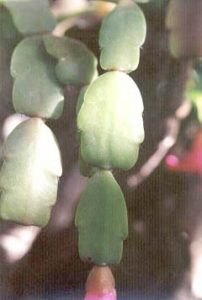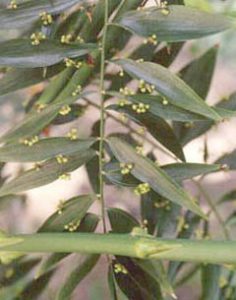CLADODE OR PHYLLOCLADE
The typical flattened photosynthetic organ of a vascular plant is the leaf, but some plant groups instead have flattened green stems (Fig 1.) as the chief photosynthetic organs. These are called either cladodes (Fig. 2) or phylloclades (“leaf-like branches”). In certain familiar cases, the cladode so resembles a leaf (Fig. 3) that the casual observer would have no reason to suspect otherwise.
The proper way to identify a phylloclade is to examine carefully a rapidly growing vegetative shoot, on which leaves are still present. A phylloclade is subtended by a leaf (Fig.4), normally one that is small or scale-like, and the leaves of these species are ephemeral and soon abscise. Of the cultivated examples, the apply-named tapeworm plant (Fig. 5), Muehlenbeckia platyclados (Family Polygonaceae), has the most conspicuous leaves (Fig. 6); its phylloclades have horizontal lines (perpendicular to the veins), showing the positions of the nodes, and from the axillary buds at nodes are where the flowers arise along the phylloclade edges. Occasionally authors have referred to these plants as having epiphyllous flowers (Fig. 7) (“on leaf”), but this is technically wrong, given that phylloclades are stems. The phyllocladous woody species of Phyllanthus (Family Euphorbiaceae) are other, strikingly similar dicotyledonous examples (The genus name means “leaf flowers.”).
Among monocotyledons, several genera with cladodes are widely cultivated. Species of Asparagus (Fig. 8) generally have needle-like cladodes, although in some species of asparagus they can be flattened (see also Myrsiphyllum). The closely related family Ruscaceae (eight species), including butcher’s broom (Fig. 4) (Ruscus aculeatus), Caesar’s laurel (Fig. 2) (R. hypoglossum), Alexandrian laurel (Danae racemosa), and climbing butcher’s broom (Fig. 9) (Semele androgyna), has cladodes that, again, appear to form flowers on leaves but in reality have flowers produced from nodes.
The genus Phyllocladus is an Australasian gymnosperm genus having scale-like leaves and lobed phylloclades that resemble pinnately compound leaves.
Most genera of cladode-producing plants occur in the cactus family (Cactaceae). More than 200 species are the platyopuntias (a.k.a. prickly pears) and nopaleas of the genus Opuntia in subfamily Opuntioideae. These are comparatively thick cladodes, with pads often exceeding one centimeter in thickness, and the flattened pads, also called joints, have nodes on the two flat surfaces as well as along the edges, arranged in a helical pattern. A narrow leaf forms at each node, and from the axillary bud forms a determinate short shoot (the areole) on which are produced modified primordia that are leaf spines. The foliar leaves soon abscise, leaving the spine-covered cladode to perform photosynthesis. Shrub and tree opuntias, such as on the Galapagos Archipelago, have trunks and branches composed of a series of cladodes attached end to end.
Flattened green stems also appear in more than a dozen genera of cactus epiphytes and hemiepiphytes. Also referred to as 2-ribbed, most of these flattened stems have areoles arranged only along the two edges, not on the broad surfaces, although in the rhipsalid epiphytes this is not always true. In general the 2-ribbed epiphytic stems have evolved from species having three or four ribs on the stem, hence they formed via a different developmental and evolutionary sequence than did the platyopuntias. Some cactus epiphytes exhibit two, three, and four ribs on a single individual, and there commonly are differences in stem morphology from juvenile versus adult types.
The term pterocauly is occasionally used to identify a stem that has thin ribs or wings. Examples of green, leaf-like pterocauls are found among succulents of the genus Cissus (grape family, Vitaceae), climbing species of yam (Dioscorea, Family Dioscoreaceae), and certain Andean species of Baccharis (Family Asteraceae).
Some authors have also classified all photosynthetic stems as cladodes, but to do so distorts its original meaning of having a flattened stem.
A leaf is generally thin enough for direct sunlight intercepted by one surface to pass through the tissue and adequately illuminate and excite all photosynthetic pigments of the cells. In most plant communities, leaf thickness is less than 0.6 millimeters, except in leaf succulents. The visible spectrum of sunlight (called PFD or PPFD) attenuates as it is absorbed by pigments of the leaf, hence most of the energy of sunlight never exits the leaf on the back side. However, if the flattened photosynthetic organ is very thick, even the lower photosynthetic cells along the light pathway may not receive enough useful radiation for saturation to occur. Some cladodes are, in fact, noticeably thicker than typical leaves, perhaps because they include additional stem tissues, so that each cladode basically has a photosynthetic unit on each side of the cladode and nonparticipatory tissues in the center that do not receive enough solar radiation to have chlorophyll. In general, cladodes have stomates on both flat surfaces, and this permits CO2 to be taken up independently by each side so that CO2 does not have to diffuse long distances from only one side.
The term phylloclade should not be confused with cladophyll (“branch-like leaf”), i.e., a phyllode. A cladophyll is a flattened petiole or rachis of a leaf, not a stem.
Flattened stems are relatively fixed structures, incapable of reorienting once formed. Research on cactus cladodes has shown that the pads (cladodes) for a plant tend to become oriented so as to maximize PFD interception by the plant canopy over the course of the year. So it is found that optimal cladode orientation is different at different latitude and on different slopes. Earlier interpretations hypothesized that the pads were oriented instead to minimize midday solar heating during summer, but that interpretation apparently is incorrect and is basically a secondary result or benefit of maximizing light interception and, hence, total biomass accumulation.
Click here to add your own text
Click here to add your own text
Click here to add your own text
Click here to add your own text
Click here to add your own text
Click here to add your own text
Click here to add your own text
Click here to add your own text
Click here to add your own text
Click here to add your own text
Click here to add your own text
Click here to add your own text
Click here to add your own text










